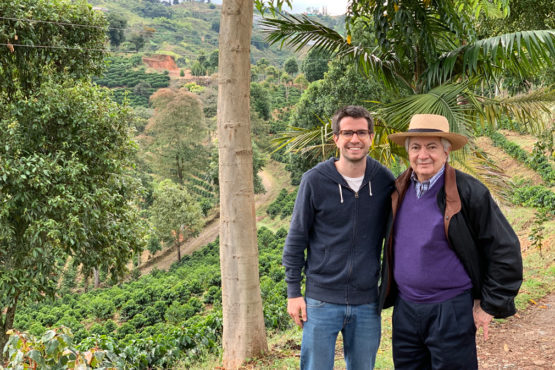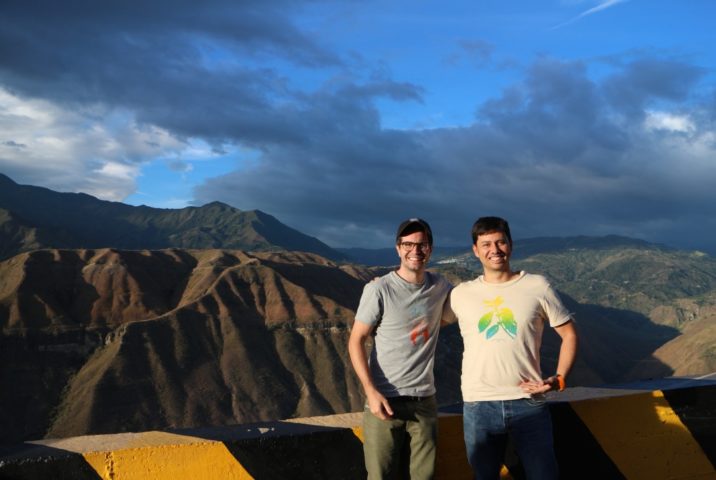Colombia
Coffees from Colombia are some of our most important offerings. This is due to the quality, versatility, diversity and relative value of the coffees available, and the fact that we’re able to source delicious coffees from there almost all year round.
With a production of over 12 million bags a year, Colombia is the third-largest exporter of coffee in the world, behind Brazil and Vietnam. There are nearly 600,000 coffee producers in the country, and over two-thirds of its production comes from small farms less than three hectares in size. Most farmers have their own wet mills, or ‘micro beneficios,’ where they process the coffee themselves before selling it in parchment.
Coffee is grown across 588 municipalities and 20 growing regions in Colombia, at elevations of 1,200-2,200 metres above sea level. These regions are all very diverse and produce an impressive variety of coffees and flavour profiles, due to the country’s mountainous topography, wind patterns, and proximity to the equator, which combine to create a series of tropical microclimates. Most regions have two harvests a year (the main harvest and a “mitaca” or fly crop), making it possible to source coffee from Colombia pretty much all year round.
History of Coffee in Colombia
Coffee was introduced to Colombia in the late 1700s, with the first plantings in the country’s north. Commercial production and export officially started in the 1810s but remained limited. Throughout the 19thcentury, coffee plants spread across the country from farm to farm, but it wasn’t until the 20thcentury that Colombia established itself as a major coffee-growing nation, boosted by the work of the Federación Nacional de Cafeteros de Colombia (FNC).
Founded in 1927, the FNC is a non-government organisation that provides a range of services and support to the country’s coffee producers, irrespective of their farm size or volume of production. The marketing department of FNC develops campaigns to encourage both the international and domestic consumption of specialty-grade Colombian coffees. Along with the Department Committee of Coffee Growers of Quindío, the FNC built coffee theme park it still operates, including a coffee-history museum, coffee garden, traditional farmer’s house, and even a rollercoaster!
The FNC guarantees a purchase price for any Colombian-grown coffee, aiming to provide financial security to farmers who then have the option to find private buyers in specialty markets or tender their coffee to FNC and receive a relatively stable price at any point during the year. Although this pricing is tied to the global commodities market, it is standardised and helps to relieve market pressures, while providing some certainty for producers.
The scientific arm of FNC is called Cenicafé, and it is devoted to research and development, and to sharing their findings with producers throughout the country. An example of this is Cenicafé’s ecological system for coffee processing, a self-developed method that reduces contamination of local water sources by 90% and reduces water consumption by 95%. Cenicafé provides employment for more than 1,500 field workers, who are deployed to meet and consult with farmers on issues like soil management, processing techniques, variety selection, disease prevention and treatment, as well as other agricultural features of coffee production. Cenicafé’s aggressive treatment and recommended preventative techniques have also been key in minimising the impact of coffee-leaf rust among farmers, as these have the potential of minimising yields severely. In order to fund this work, a tax is imposed on all coffee exports regardless of an individual producer’s participation in the services, marketplace, and programs offered by FNC.
Today, Colombia produces exclusively Arabica coffee. The three most common varieties are Caturra, Colombia and Castillo. Most farmers have a mix of these growing on their properties, although there are some who separate production by variety. Bourbon, Catimor, Typica and Tabi varieties are also grown in Colombia, while rarer varieties like Gesha, Rume Sudan and Chiroso are becoming more popular among specialty-focused farmers in recent years.
Our Supply Partners
We are fortunate to work with Pergamino in Colombia. Pergamino is a progressive, family-owned company, that produce coffee on their own farms, and also work very closely with thousands of smallholder producers all over Colombia as part of their Allied Producer Program. Established in 2013, the program aims to connect smallholder farmers with specialty buyers who pay quality-based premiums, while increasing transparency on how and where the coffees produced are sold. Today, the program operates in five different regions in Colombia – Antioquia, Cauca, Tolima, Nariño and Huila – and accounts for almost 80% of Pergamino’s exports.
Pergamino’s pioneering approach has allowed us to connect with some extremely dedicated and quality-focused smallholder producers and to start to build long term and mutually beneficial relationships with them.
Key Coffee Growing Regions
Colombia has 32 departments in total, and 20 of these produce coffee. Melbourne Coffee Merchants sources coffee from the following regions in Colombia:
ANTIOQUIA
Antioquia is located in central northwestern Colombia. Coffee was introduced to the region in the latter part of the 19thcentury. Today, this mountainous, fertile department has 128,000 hectares of coffee that is produced by a mix of large estates and tiny farms.
Antioquia only recently became more accessible to coffee buyers, thanks to a transformation of the department led by Sergio Fajardo, who was the governor of the department between 2012-2016. Sergio transformed Antioquia’s capital city, Medellín, from a violent and dangerous place to a world-class tourist destination with a strong economy. Coffee has played a significant role in this transformation and, as access to many producers has improved, the region has become one of Colombia’s most important and celebrated coffee-producing areas.
CAUCA
The department of Cauca is best known for its coffee from Inzá and the city of Popayán. Cauca is located in Colombia’s southwest, on the ‘Macizo Colombiano’ (the Colombian Plateau), between the high peaks of Tolima and Huila, and facing west over the Pacific Ocean. The region has excellent conditions for growing quality coffee, with high elevations and rich volcanic soil. The plateau also has a very stable climate year-round, thanks to its proximity to the equator, as well as the surrounding mountains, which protect the coffee against humidity from the Pacific and trade winds from the south.
HUILA
The department of Huila is located in the southwest of Colombia. It is a more rural region than Cauca, and it is well-known for the quality of its coffee. Huila is one of the largest coffee-producing regions in the country. This department has optimal conditions for producing excellent coffee, with a combination of rich soil and ideal topography.
Coffee farming within the region is almost all small-scale, with farmers typically owning an average 1.5 hectares of land. These small farms are tended by individual families, with labour very rarely contracted out, which leads to more thorough and intensive management practices and great pride in the final product (which is often seen as a representation of the family).
NARIÑO
Nariño lies in the far south of Colombia, bordering Ecuador along the high peaks of the Andes. The region is strikingly mountainous and boasts no fewer than five volcanoes: Chiles, Cumbal, Azufral, Doña Juana and Galeras.
Unlike other regions in Colombia there is only one harvest in Nariño, which typically runs from May to August. Coffees here are grown at very high elevations – some farms are located on mountainsides that reach 2,200 metres above sea level, making it some of the highest grown coffee in the world. Typically, it is very difficult to produce coffee at such high altitudes, but Nariño’s proximity to the equatorial line and the steep hills around the volcanoes provide a great angle for sun exposure (which is relatively constant and powerful year-round), creating the right microclimate for coffee plants to thrive.
Warm air rises from the deep canyons at night and acts like a protective blanket for the coffee plants perched on the mountain tops. These combined attributes allow coffee to thrive in cooler-than-normal daily conditions and results in concentrated flowering and long cherry maturation periods, giving time for sugars to develop in the fruit and resulting in a uniquely sweet and complex cup profile.
Some of Colombia’s best coffees come from Nariño, however, due to the remoteness of many of the farms and their small size (producers in the region typically own less than two hectares of land), many smallholders in this region have found it difficult to gain access to markets for higher quality.
TOLIMA
Tolima is located in the Andean region, in Colombia’s centre-west. Historically, Tolima has been very difficult to access due to its isolation and instability. For many years, the region has been under the control of Colombia’s notorious rebel group, the FARC, and as a result it has been unsafe and violent. Since 2012, safe access to this region has been possible as a result of peace talks between the Colombian government and the rebels. Since this time, some stunning coffees from small producers have been discovered, mainly via cooperatives.
The word ‘Tolima’ comes from the local indigenous language and means a “river of snow or cloud”. The region sits on the Cordillera Central, in the middle of the three mountain ranges that create microclimates well-suited to high-quality coffee production. Coffee is the leading agricultural activity in the region, followed by beans and cattle.


